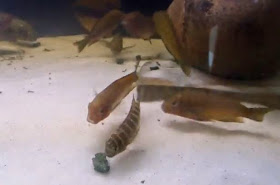Fish Nutrition 101
By Clayn; Creator of the formula for and Co-Founder of Paradigm Fish Foods, now the newer formula for AAP Custom
The Digestive Biology of Fish
Protein is used for growth and maintaining muscle and tissue.
Fat is the purest form of energy. Roughly 2.25 times more energy than starch or sugar.
Starch provides energy. Starch energy is used before Fat energy. Fish don't store Starch energy very well so it is used first.
Sugar provides energy. Sugar energy is used before Fat energy. Fish don't store Sugar energy very well so it is used first.
Fiber acts as a laxative. All fiber is passed. However it has no effect on the ecology of your aquarium.
Minerals are used by fish. Excess minerals are passed. Calcium is used to build bones and cartilage. I highly doubt the amount of excess Calcium in our food will effect your water chemistry.Excess Phosphorus does have the potential to grow algae. However nitrates (the end process of the nitrogen cycle) also has the potential to grow algae. Excess Potassium levels are negligible.
Moisture is slowly turning the fat in your food rancid. Preservatives do slow the process but only for so long.
Vitamins are provided in our ingredients. Our low temperature dehydration process allows us to do this.
The Balancing Act
Protein: Too little Protein and your fish don't grow properly. Too much over time causes damage to the fish's kidneys.
Protein Digestibility of Main Ingredients: Dried Egg Whites 100%, Whole Menhaden Fish Meal 93%, Shrimp Meal 87%, Spirulina 87% and Green Pea Flour 70%
Energy:
Starch, Sugar and Fat: It takes around 15% binder to hold fish food together. The use of excessive starch can provide nearly if not all of the energy a fish needs. In this case what happens to the fat? It gets stored in the fish's liver leading to fatty liver condition. Many biologist's believe that fatty liver condition leads to a shorter lifespan. This subject has taken a lot of our research and testing time in developing formulas that find balance between fish that don't have enough stored energy to breed and fish with excessive fat stored in its liver. Yes we actually created formulas and tested them with such low energy levels that fish that were breeding stopped.
Fiber - Acts as a laxative. If the percentage of fiber in our food caused diarrhea we would have noticed it in our food testing. Some would have you believe that 12% Fiber is too much for Carnivorous fish. This is simply not the case and our testing on live subjects proves it.
Minerals are also known as Ash. As far as our Whole Menhaden Fish Meal (containing 19% Ash) is concerned we run it through a sieve and remove roughly 6% of the scales and large pieces of bone to provide a superior product. Our Shrimp Meal is the freshest that we have found and has a very good attractant value. Our Shrimp Meal contains 48% Protein with a complete amino acid profile. Its Protein digestibility is 87% which is the same as Whole Antarctic Krill.
Shrimp Meal contains 4% fat. Shrimp Meal contains 8% Fiber. Shrimp Meal contains 31% minerals. 31% Minerals is a high number. However the ability to add quality protein and fat to provide balance to our formulas is well worth the trade off. Shrimp Meal contains 9% Moisture. The use of Shrimp Meal also allows us to complete the Green Pea Flour's amino acid profile.
Shrimp Meal contains 4% fat. Shrimp Meal contains 8% Fiber. Shrimp Meal contains 31% minerals. 31% Minerals is a high number. However the ability to add quality protein and fat to provide balance to our formulas is well worth the trade off. Shrimp Meal contains 9% Moisture. The use of Shrimp Meal also allows us to complete the Green Pea Flour's amino acid profile.
Moisture - The lower the moisture content the longer the food lasts. Water is the cheapest ingredient in fish food.
This is a delicate balancing act to limit Protein, Fat, Starch and Sugar percentages that have a negative impact on the long term health of your fish. This increase in the Fiber and Mineral percentages have very minimal if any negative impact on the ecosystem in your aquarium. This trade off is well worth it.
Common Questions:
Isn't high mineral also known as ash content an indicator of inferior quality ingredients? See The Balancing Act Minerals Section. and Minerals in the Basic Understanding of the Digestive Biology of Fish Section. In short the worst case scenario is the excess phosphorus might contribute to algae growth.
Doesn't high fiber percentages cause diarrhea? See The Balancing Act Fiber Section.
OTHER ARTICLES BY THE AUTHOR
*Whats wrong with making Dough in Fish Food?
*Cyanobacteria (Spirulina) and Algae - Pond Grown vs. Naturally Grown
*Probiotics, Prebiotics, Soluble Fiber and Resistant Starch
*How to Read a Fish Food Label & Energy (Fat, Starch and Sugar)
FURTHER SUGGESTED RESOURCES:

Aquarium Fish Nutrition
Common Aquarium Keeping Myths
AAP Custom Fish Foods by Fish Food Guru Clay Neighbors
• Carnivore, • Omnivore, • Herbivore, • Grow, • Graze (compare to sinking algae wafers)
There is simply NO better prepared fish food; NOT Repashy, NOT New Life Spectrum, NOT NorthFin, etc.
Best energy levels, best fiber content, best protein optimization, no added supplements.

Aquarium or Pond UV Sterilization
A MUST read article for any serious aquarium keeper, especially with the plethora of junk UV Sterilizers that are not really even Sterilizers flooding the market from Amazon, eBay, & others

TMC Premium Fluidized Sand Bed Bio Filters
Labels: algae, Aquarium fish food, Digestive Biology of Fish, fat, Fish Nutrition, minerals, protein, starch, sugar






 AAP AquaRay LED; GroBeam, AquaBeam
AAP AquaRay LED; GroBeam, AquaBeam